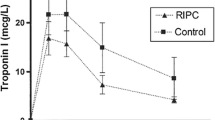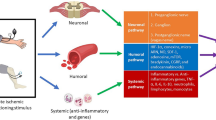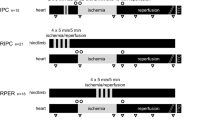Abstract
Background
The mechanism underlying remote ischemic conditioning (RIC) remains unclear. We investigated whether RIC protects the heart through the activation of the adenosine receptor and the PI3K-Akt pathway at the onset of myocardial reperfusion.
Methods and results
Domestic pigs (27–35 kg) were subjected to in situ left anterior descending coronary artery ischemia (60 min) followed by reperfusion (180 min) and randomised to the following: (1) Control- No additional intervention; (2) Remote ischemic preconditioning (RIPC)- Four-5 min cycles of lower limb ischemia/reperfusion were administered prior to myocardial ischemia; (3) RIPC + Wort or 8-SPT: Wortmannin (Wort 20 μg/kg, a PI3K inhibitor) or 8-sulfophenyltheophylline (8-SPT 10 mg/kg, an adenosine receptor inhibitor) were administered intravenously 30 s before myocardial reperfusion to RIPC-treated animals; (4) Remote ischemic perconditioning (RIPerC)- Four-5 min cycles of lower limb ischemia/reperfusion were applied 1 min before myocardial reperfusion; (5) RIPerC + Wort or 8-SPT: Wort or 8-SPT were given 30 s before myocardial reperfusion to RIPerC-treated animals. Both RIPC and RIPerC reduced myocardial infarct size (13.3 ± 2.2% with RIPC, 18.2 ± 2.0% with RIPerC versus 48.8 ± 4.2% in control:P < 0.05:N ≥ 5/group). Wortmannin abolished the infarct-limiting effects of RIPC (33.2 ± 6% with RIPC + Wort versus 13.3 ± 2.2% with RIPC:P < 0.05:N ≥ 5/group) but not RIPerC (18.0 ± 3.4% with RIPerC + Wort versus 18.2 ± 2.0% with RIPerC:P > 0.05:N ≥ 5/group). 8-SPT did not influence the infarct-limiting effects of either RIPC or RIPerC. Western blot analysis confirmed Wortmannin-sensitive PI3K and Akt activation at myocardial reperfusion in RIPC-treated hearts.
Conclusions
In the porcine heart, both RIPC and RIPerC both reduce myocardial infarct size and with RIPC but not RIPerC this cardioprotective effect is associated with the activation of the PI3K-Akt pathway at reperfusion.



Similar content being viewed by others
References
Andreka G, Vertesaljai M, Szantho G, Font G, Piroth Z, Fontos G, et al. Remote ischemic postconditioning protects the heart during acute myocardial infarction in pigs. Heart. 2007;93:749–52.
Bopassa JC, Ferrera R, Gateau-Roesch O, Couture-Lepetit E, Ovize M. PI 3-kinase regulates the mitochondrial transition pore in controlled reperfusion and postconditioning. Cardiovasc Res. 2006;69:178–85.
Botker HE, Kharbanda R, Schmidt MR, Bottcher M, Kaltoft AK, Terkelsen CJ, et al. Remote ischemic conditioning before hospital admission, as a complement to angioplasty, and effect on myocardial salvage in patients with acute myocardial infarction: a randomised trial. Lancet. 2010;375:727–34.
Breivik L, Helgeland E, Aarnes EK, Mrdalj J, Jonassen AK. Remote postconditioning by humoral factors in effluent from ischemic preconditioned rat hearts is mediated via PI3K/Akt-dependent cell-survival signaling at reperfusion. Basic Res Cardiol. 2011;106:135–45.
Ding YF, Zhang MM, He RR. Role of renal nerve in cardioprotection provided by renal ischemic preconditioning in anesthetized rabbits. Sheng Li Xue Bao. 2001;53:7–12.
Hausenloy DJ, Lecour S, Yellon DM. Reperfusion injury salvage kinase and survivor activating factor enhancement prosurvival signaling pathways in ischemic postconditioning: two sides of the same coin. Antioxid Redox Signal. 2011;14:893–907.
Hausenloy DJ, Mwamure PK, Venugopal V, Harris J, Barnard M, Grundy E, et al. Effect of remote ischemic preconditioning on myocardial injury in patients undergoing coronary artery bypass graft surgery: a randomised controlled trial. Lancet. 2007;370:575–9.
Hausenloy DJ, Tsang A, Mocanu M, Yellon DM. Ischemic preconditioning protects by activating pro-survival kinases at reperfusion. Am J Physiol Heart Circ Physiol. 2005;288:H971–6.
Hausenloy DJ, Yellon DM. New directions for protecting the heart against ischemia-reperfusion injury: targeting the Reperfusion Injury Salvage Kinase (RISK)-pathway. Cardiovasc Res. 2004;61:448–60.
Hausenloy DJ, Yellon DM. Reperfusion injury salvage kinase signalling: taking a RISK for cardioprotection. Heart Fail Rev. 2007;12:217–34.
Hausenloy DJ, Yellon DM. Remote ischemic preconditioning: underlying mechanisms and clinical application. Cardiovasc Res. 2008;79:377–86.
Heidbreder M, Naumann A, Tempel K, Dominiak P, Dendorfer A. Remote vs. Ischemic preconditioning: the differential role of mitogen-activated protein kinase pathways. Cardiovasc Res. 2008;78:108–15.
Heusch G, Schulz R. Remote preconditioning. J Mol Cell Cardiol. 2002;34:1279–81.
Hoole SP, Heck PM, Sharples L, Khan SN, Duehmke R, Densem CG, et al. Cardiac Remote Ischemic Preconditioning in Coronary Stenting (CRISP stent) study: a prospective, randomized control trial. Circulation. 2009;119:820–7.
Iliodromitis EK, Georgiadis M, Cohen MV, Downey JM, Bofilis E, Kremastinos DT. Protection from post-conditioning depends on the number of short ischemic insults in anesthetized pigs. Basic Res Cardiol. 2006;101:502–7.
Kerendi F, Kin H, Halkos ME, Jiang R, Zatta AJ, Zhao ZQ, et al. Remote postconditioning. Brief renal ischemia and reperfusion applied before coronary artery reperfusion reduces myocardial infarct size via endogenous activation of adenosine receptors. Basic Res Cardiol. 2005;100:404–12.
Li J, Xuan W, Yan R, Tropak MB, Jean-St-Michel E, Liang W, et al. Remote preconditioning provides potent cardioprotection via PI3K/Akt activation and is associated with nuclear accumulation of beta-catenin. Clin Sci (Lond). 2011;120:451–62.
Liem DA, Verdouw PD, Ploeg H, Kazim S, Duncker DJ. Sites of action of adenosine in interorgan preconditioning of the heart. Am J Physiol Heart Circ Physiol. 2002;283:H29–37.
Lim SY, Yellon DM, Hausenloy DJ. The neural and humoral pathways in remote limb ischemic preconditioning. Basic Res Cardiol. 2010;105:651–5.
Mocanu MM, Bell RM, Yellon DM. PI3 Kinase and not p42/p44 appears to be implicated in the protection conferred by ischemic preconditioning. J Mol Cell Cardiol. 2002;34:661–8.
Pell TJ, Baxter GF, Yellon DM, Drew GM. Renal ischemia preconditions myocardium: role of adenosine receptors and ATP-sensitive potassium channels. Am J Physiol. 1998;275:H1542–7.
Przyklenk K, Bauer B, Ovize M, Kloner RA, Whittaker P. Regional ischemic ‘preconditioning’ protects remote virgin myocardium from subsequent sustained coronary occlusion. Circulation. 1993;87:893–9.
Rentoukas I, Giannopoulos G, Kaoukis A, Kossyvakis C, Raisakis K, Driva M, et al. Cardioprotective role of remote ischemic periconditioning in primary percutaneous coronary intervention: enhancement by opioid action. JACC Cardiovasc Interv. 2010;3:49–55.
Schmidt MR, Smerup M, Konstantinov IE, Shimizu M, Li J, Cheung M, et al. Intermittent peripheral tissue ischemia during coronary ischemia reduces myocardial infarction through a KATP-dependent mechanism: first demonstration of remote ischemic perconditioning. Am J Physiol Heart Circ Physiol. 2007;292:H1883–90.
Skyschally A, van Caster P, Boengler K, Gres P, Musiolik J, Schilawa D, et al. Ischemic postconditioning in pigs: no causal role for RISK activation. Circ Res. 2009;104:15–8.
Solenkova NV, Solodushko V, Cohen MV, Downey JM. Endogenous adenosine protects preconditioned heart during early minutes of reperfusion by activating Akt. Am J Physiol Heart Circ Physiol. 2006;290:H441–9.
Takaoka A, Nakae I, Mitsunami K, Yabe T, Morikawa S, Inubushi T, et al. Renal ischemia/reperfusion remotely improves myocardial energy metabolism during myocardial ischemia via adenosine receptors in rabbits: effects of “remote preconditioning”. J Am Coll Cardiol. 1999;33:556–64.
Thielmann M, Kottenberg E, Boengler K, Raffelsieper C, Neuhaeuser M, Peters J, et al. Remote ischemic preconditioning reduces myocardial injury after coronary artery bypass surgery with crystalloid cardioplegic arrest. Basic Res Cardiol. 2010;105:657–64.
Tsang A, Hausenloy DJ, Mocanu MM, Yellon DM. Postconditioning: a form of “modified reperfusion” protects the myocardium by activating the phosphatidylinositol 3-kinase-Akt pathway. Circ Res. 2004;95:230–2.
Venugopal V, Hausenloy DJ, Ludman A, Di Salvo C, Kolvekar S, Yap J, et al. Remote ischemic preconditioning reduces myocardial injury in patients undergoing cardiac surgery with cold-blood cardioplegia: a randomised controlled trial. Heart. 2009;95:1567–71.
Acknowledgements
We thank ELPEN Pharmaceutical Co. Inc. for continued support.
Funding
We wish to thank the British Heart Foundation for continued support.
Conflict of interest
None declared.
Author information
Authors and Affiliations
Corresponding author
Rights and permissions
About this article
Cite this article
Hausenloy, D.J., Iliodromitis, E.K., Andreadou, I. et al. Investigating the Signal Transduction Pathways Underlying Remote Ischemic Conditioning in the Porcine Heart. Cardiovasc Drugs Ther 26, 87–93 (2012). https://doi.org/10.1007/s10557-011-6364-y
Published:
Issue Date:
DOI: https://doi.org/10.1007/s10557-011-6364-y




